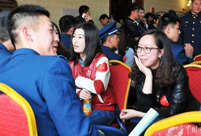 'Model husband' shatters image of love
'Model husband' shatters image of love
 Can animals smile? Or put on a happy face
Can animals smile? Or put on a happy face
 Geng Xuan crowned at 9th China Super Model Contest
Geng Xuan crowned at 9th China Super Model Contest
 Top 10 billionaires in the liquor industry
Top 10 billionaires in the liquor industry
 Backstage at China Fashion Week
Backstage at China Fashion Week
 Ballerinas anywhere but onstage
Ballerinas anywhere but onstage
 Top 10 safest airlines in the world
Top 10 safest airlines in the world
 Posters of 33rd HK Film Awards unveiled
Posters of 33rd HK Film Awards unveiled
 Top 10 most popular instant messaging apps in the world
Top 10 most popular instant messaging apps in the world
 Inspiring shadow images of Chinese army
Inspiring shadow images of Chinese army
Second, we should foster a general environment for integrated development and form an Asian community of common destiny. Economic integration is central to achieving common development in Asia. Asia's beautiful future hinges upon not only the development of each and every country but, more importantly, the common progress of the whole region. As a Chinese adage aptly puts it, "A single thread cannot be spun into a cord. And a single tree cannot create a forest." We the Asian countries need to deepen result-oriented cooperation in all fields, pursue integration through opening-up and development through integration, strengthen economic ties, seize the opportunity of innovation-driven development, and thus hold the destiny of development in our own hands.
Infrastructure connectivity is a basic condition for integrated development. Countries in the region should join hands and speed up infrastructure construction including rail, road, air and water transportation. China is ready to work with countries involved to draw up plans for building the Bangladesh-China-India-Myanmar (BCIM) Economic Corridor and the China-Pakistan Economic Corridor, and upgrade China-ASEAN FTA. China will continue to promote the important projects of the Silk Road Economic Belt and the 21st Century Maritime Silk Road this year. China is ready to intensify consultations with relevant parties in and outside Asia on the preparations for the Asian Infrastructure Investment Bank and hopes that the bank can be officially launched at an early date. Industrial complementarity is a key aspect of integrated development. We the Asian countries should take advantage of our geographical proximity to deepen cooperation across the upstream, mid-stream and downstream industrial chains, and build an industrial network and economic system that draw on our respective comparative strengths. The destiny of the Asian economy hinges on reform, innovation and structural adjustment. Asian countries need to ride the global trend of new technology revolution, enhance exchanges, and draw on each other's experience to advance scientific and technological progress and personnel training, especially young people, boost the "new economy" featuring green development, energy, environmental protection and the internet so as to seize an advantageous position in future development and raise industrial and economic competitiveness. This will not only increase the internal impetus for achieving sustained development in our region, but also create new opportunities for global economic recovery.
Third, we should maintain the general environment of peaceful development and build an Asian community of shared responsibilities. Regional turbulence courts disaster while stability in the neighborhood brings prosperity. Asia owes its progress to a peaceful and stable regional environment, and peace and stability are the fundamental safeguards for Asia's development. Sixty years ago, China, India and Myanmar jointly initiated the Five Principles of Peaceful Coexistence, which have become basic norms governing international relations. These principles embody Oriental wisdom and represent a major contribution to human civilization, and we should pass on the vision of peaceful coexistence from generation to generation. A close neighbor is better than a kinsman afar, and close neighbors can become best friends. To achieve peace and stability in Asia, we the Asian countries should build consensus, make active efforts and jointly fulfill our due responsibilities. We should promote security dialogue and consultation, strengthen cooperation on non-traditional security issues, including disaster management, maritime search and rescue, counter-terrorism and combating transnational crimes, and actively explore the establishment of a regional security cooperation framework in Asia.
Here I wish to emphasize that China is committed to peaceful development. We pursue a neighborhood policy of building amity and friendship, and we are firm in our resolve to uphold China's territorial sovereignty. We also follow a clear-cut policy of seeking peaceful solutions to disputes. We will give full support to initiatives that help strengthen maritime cooperation. We will not accept acts that undermine stability in the South China Sea. We Chinese believe in repaying kindness with kindness and meeting wrongdoing with justice. We value friendship and never treat friends unfairly, and we also stand by principles and firmly uphold our fundamental position. A peaceful and stable South China Sea is in the interest of all littoral countries, including China. China is ready to steadily advance consultation on a code of conduct in the South China Sea within the framework of the Declaration on the Conduct of Parties in the South China Sea, and work with other countries to ensure peace, stability and freedom of navigation in the South China Sea. China loves peace and cherishes development. It is ready to work with other countries in the region to build a peaceful, prosperous and open Asia and maintain peace, stability and tranquility in our neighborhood by enhancing political mutual trust.
Ladies and Gentlemen,
Asia's development is important to the future of the world, and China's development is closely bound up with Asia.
To keep China's economy running within a proper range is both a basic target of China's current macro-control and its medium-to-long-term policy goal. We have set this year's target of economic growth at about 7.5%. The word "about" indicates that there is a range for the GDP growth. As long as there is fairly sufficient employment and no major fluctuations, the actual GDP growth will be considered to be within the proper range, be it slightly higher or lower than the 7.5% target. Statistics show that urban employment continued to increase, individual income, corporate profits and fiscal revenue registered steady growth, consumer prices remained stable, growth of electricity consumption started to rise and there were positive dynamics in structural adjustment. In short, the Chinese economy has got off to a stable and good start. On the other hand, the upturn of the Chinese economy is not yet on a solid footing, downward pressure still exists, and difficulties in some fields must not be underestimated. These problems show the impact exerted on China by the complex international environment; they also reflect the prominent challenges and economic slowdown that China faces.
Preparedness ensures success. Faced with this complex situation, we need to calmly assess the current developments, stay focused, and take initiatives as called for. In exercising macro-control, we will endeavor to strike a balance between aggregate supply and demand, focus on improving the economic structure, ensure proper policy intensity of macro-control in the light of changing situation and take targeted and differentiated measures as appropriate. Last year, we pursued creative thinking and methods in exercising macro-control and gained new experience in this regard. We will not resort to short-term massive stimulus policies just because of temporary economic fluctuations and we will pay more attention to sound development in the medium to long run and strive for sustained and sound economic development. With all the principles established and policy options at our disposal, we can handle all possible risks and challenges. China's development has strong resilience. We have the capabilities and confidence to keep the economy functioning within the proper range.
There are conditions in place for the Chinese economy to achieve sustained sound growth. China has a big economy and large foreign exchange reserves. There is steady and coordinated progress in advancing the new type of industrialization, IT application, urbanization and agricultural modernization. And the Chinese market has broad space. There is much we can do to boost China's development. In particular, there is a large urban-rural gap in development. Population in the central, western and northeastern regions accounts for over 60% of the national total. And per capita GDP has just exceeded US$5,000. To narrow the gap between urban and rural areas and among different regions will unleash huge potential of growth. We have introduced a series of policies to advance reform, adjust structure and benefit the people, and more such measures are under consideration. All these will help ensure such steady growth.


 Wonderful moment of China's airborne forces
Wonderful moment of China's airborne forces Bai Baihe shoots for fashion magazine
Bai Baihe shoots for fashion magazine Red terraced fields in Dongchuan of Yunnan
Red terraced fields in Dongchuan of Yunnan Jiaju Tibetan Village
Jiaju Tibetan Village Spring dating
Spring dating Confucius institute at UC Davis
Confucius institute at UC Davis Little painted faces at temple fair
Little painted faces at temple fair Top 10 safest airlines in the world
Top 10 safest airlines in the world Foreign students at China-Myanmar border
Foreign students at China-Myanmar border The backstage of the Fashion Week
The backstage of the Fashion Week College students in Han costumes
College students in Han costumes Postgraduate works as waitress
Postgraduate works as waitress Life in a Lahu village in Yunnan
Life in a Lahu village in Yunnan An orphan’s wedding
An orphan’s wedding Hollywood documentary brings Diaoyu Islands truth to new audience
Hollywood documentary brings Diaoyu Islands truth to new audienceDay|Week|Month